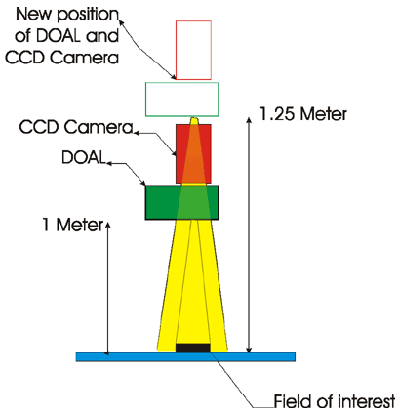When an application requires an illumination source, a lighting designer working with the application engineer can provide an optimal solution if the application’s attributes are described in light intensity and uniformity values at the field of interest.
This effort can be confusing, because intensity and uniformity can be described using several different physical attributes.
The following information is meant to provide an explanation, and serve as a guideline to help application engineers specify uniformity and intensity values with optimal meaning.
Quantifying Light
Most lighting specifications fall under three basic categories: a reflected value, a transmitted value, or an emitted value. To have meaning for the lighting designer, all values must be measured from a specific direction, over a defined area, at a known distance. Furthermore, these values are quantified using two basic systems: Photometric or Radiometric.
Photometric values (Luminous intensity), represent visible light (380-770nm) weighted by the visual sensitivity of the average human eye, while radiometric values, comprise the entire electromagnetic output of the source, including UV and IR in units of absolute power density with no weighting.
Regardless of application, many engineers mistakenly measure or specify luminous flux of a source, which is the total photometric power of a point source projected onto a sphere, measured in Lumens. This value is equivalent to the total energy output of the lamp. Because a vast majority of applications use light in a defined area, from a specified direction and distance, lighting designers are trained to quantify the intensity and uniformity of an energy beam at a specific point in space. Therefore, the lumen value is not as important as the Illuminance value, which is a measure of intensity from a given direction.
To illustrate this point, consider the following scenario in a fiber optic application: An EKE lamp is said to have a total luminous flux of 80 lumens. To increase efficiency, some of that energy is re-directed and focused using a reflector, into a bundle of fiber. Reflection losses aside, not all light enters the fiber bundle. Some light is lost as it simply misses the fiber face. Some may be lost due to restrictions imposed by the fiber’s Numerical Aperture. And still more could be lost from other factors influencing transmission efficiency (core/clad ratio, packing density, fresnel loss,final polish, etc.). These factors are not always constant. Therefore, the resulting usable power fluctuates from lamp to lamp and fiber optic component.
While the aforementioned variables differ based on the lighting technology employed, each technology has a set of variables to deal with. (The one exception is a laser; as long as the laser itself is the delivery mechanism, and will not be transmitted through another medium such as glass, a power value can be specified.)
If an Illuminance value is specified, the lighting designer knows the application engineer is asking to factor in all variables and provide a net power value at the field of interest. This is very specific, very measurable, and very repeatable.
Photometric Measurement
Illuminance is a photometric value measured in Lux (1 Lumen per meter squared). If a measurement is taken of the reflected value, then Luminance is being measured. The basic unit of luminance measurement is Candela per square meter (cd/m2). Both Lux and Candelas measure luminous intensity from a specific direction.
To illustrate the difference, our sun emits about 103 Lux of luminous intensity at the equator, at high noon. Measuring the same luminous intensity from a reflected standard will produce a value approximately109 cd/m2 (Luminance).
Since different materials reflect, absorb, or refract differently, the luminance value can change with the surface type, while the illuminance value remains constant (as long as the output remains constant) Therefore, it’s suggested to specify light requirement in Lux.
Several equivalent values exist for Lux, based on the type of measuring standard being used (metric or imperial) and the area measured. To supply a proper measurement to the lighting designer, a Illuminance photometer, equipped with a cosine filter is used.
- To convert similar values to Lux, use the Illuminance Calculator
- To convert similar values to Watts, use the Power Calculator
- To convert similar values to Candelas, use the Luminance (cd/m2) calculator
- To convert the old Candle values to Candelas use the Luminance (candelas) calculator
Radiometric Measurement
Up to this point, all information relates to the measurement and evaluation of visible light. For applications requiring UV and IR parts of the spectrum, a system measuring irradiance is required, expressed in Watts per square centimeter (W/cm2).
The best way to obtain this measurement is through the use of an irradiance meter and appropriate broadband filter. For example, an application uses a CCD imaging chip, with sensitivity range of 400-950 nanometers. Using a similarly rated broadband filter in place over the irradiance detector, position the meter at the plane of interest (field of view) to provide a reading of required intensity in watts/cm2.
Armed with this information, the lighting designer can select a light source/transmission package to provide the required irradiant flux.
Regardless of the method employed, it’s always advisable to take the measurement at the plane of interest. Most external factors are averaged into the measurement, and the distance is usually great enough to make the reading accurate.
When taking these types of measurements, it is also important to record the type of broadband filter used, the meter type, an accurate distance measurement from the source to the meter, and the angular measurement of the light beam to the detector.
Irradiance measurements can optimize performance and control cost. Consider the following hypothetical situation:
A CCD array is the image sensor for a particular application. A photometric light meter measures a light requirement of 10000 lux, from two typical quartz halogen power supplies. For this illustration, we will convert lux into W/cm2 by dividing 10000 (the lux value) by 343 Lumens/Watt (an average conversion value representing 380-770 nm) to obtain 29.2 W/M2, then divide by 10000cm2/m2 to obtain .00292 W/cm2 – the equivalent of 10000 Lux as an irradiance value.
Because the CCD array is sensitive to wavelengths beyond 700, and because the light source emits wavelengths beyond 700, the lux value is not the total measure of energy affecting the CCD chip. Therefore, a direct irradiance measurement of the same source, tuned to the response curve of the CCD array (400-950 nm), might be .25W/cm2: A factor of more than 80! From a lighting designer perspective, this information might instigate the use of a gold coated reflector halogen lamp, or an array of NIR LEDs to achieve the desired output, possibly from a single source, which would make the overall system less costly and more robust. Indeed, a major reason for the increased use of LEDs, particularly red, is their improved spectral response for the black and white CCD array.
Other Tricks of the Trade
If you’re having trouble positioning a lighting source for your application, you can calculate the net effect of moving the source by using the inverse square law:
I1)* (d12)= (l2) * (d22)
where I1 equals original lux value; d1 equals the original distance from the source; l2 equals the new lux value; and d2 equals the new distance from the source.
Here’s an illustrative example: A photometric application requires an intensity of 10000 lux from an on-axis source at a distance of 1 meter. A DOAL attachment is used with the camera to achieve the proper lighting effect, but due to design changes, physical obstructions now require the camera to mount 1.25M from the field of interest. (Fig 1)

(l2) * (d22) / (d12) = (I1)
(10000)*(1.252) / (12) = 15600 Lux
We already know the lux requirement is 10000, So when the source is moved back to 1.25M we solve for I1, and calculate a requirement of 15600 Lux, an increase of 56% to maintain the original requirement. This change can now be managed by substituting a ring light and diffuser for the DOAL (to add more light), increasing lamp intensity, changing the lamp, the source, or increasing the number of sources used.
Of course, conversions should only be used as a last resort, as nothing is more accurate than an actual measurement!
